
The Centre Pompidou, more fully the Centre national d'art et de culture Georges-Pompidou, also known as the Pompidou Centre in English, is a complex building in the Beaubourg area of the 4th arrondissement of Paris, near Les Halles, rue Montorgueil, and the Marais. It was designed in the style of high-tech architecture by the architectural team of Richard Rogers, Su Rogers and Renzo Piano, along with Gianfranco Franchini.

Brossard is a municipality in the Montérégie region of Quebec, Canada and is part of the Greater Montreal area. According to the 2021 census, Brossard's population was 91,525. It shares powers with the urban agglomeration of Longueuil and was a borough of the municipality of Longueuil from 2002 to 2006.
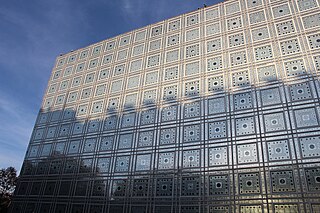
The Institut du Monde Arabe is an organisation founded in Paris in 1980 by France with 18 Arab countries to research and disseminate information about the Arab world and its cultural and spiritual values. The Institute was established as a result of a perceived lack of representation for the Arab world in France, and seeks to provide a secular location for the promotion of Arab civilization, art, knowledge, and aesthetics. Housed within the institution are a museum, library, auditorium, restaurant, offices and meeting rooms.

The culture of San Antonio reflects the history and culture of one of the state's oldest and largest cities straddling the regional and cultural divide between South and Central Texas. Historically, San Antonio culture comes from a blend of Central Texas and South Texas (Southwestern) culture. Founded as a Spanish outpost and the first civil settlement in Texas, San Antonio is heavily influenced by Mexican American culture due to Texas formerly being part of Mexico and, previously, the Spanish Empire. The city also has significant German, Anglo, and African American cultural influences. San Antonio offers a host of cultural institutions, events, restaurants and nightlife in South Texas for both residents and visitors alike.
Hervé Richard, better known as Ferdinand Richard, is a French avant-rock bass guitarist and composer.

The santralistanbul, opened in 2007, is an arts and cultural complex located at the upper end of Golden Horn in the Eyüp district of Istanbul, Turkey. The center, consisting of an energy museum, an amphitheater, concert halls and a public library, is situated within the Silahtarağa campus of Istanbul Bilgi University that was formerly the first power station of the Ottoman Empire.

Roc-aux-Sorciers is an Upper Paleolithic rock shelter site dating to the mid-Magdalenian cultural stage, ca 14,000 yBP, made famous by its relief wall carvings. The site is in the French commune of Angles-sur-l'Anglin, in Vienne. The name 'Sorcerers' Rock', with its suggestions of pagan rendez-vous, was applied to the site long before the wall-carvings were discovered.

Dominique Moulon is a historian of art and technology, art critic and curator, specializing in French digital art. He is the author of the books Art contemporain nouveaux médias and Art Beyond Digital.

The Fine Arts Museum of Nantes, along with 14 other provincial museums, was created, by consular decree on 14 Fructidor in year IX. Today the museum is one of the largest museums in the region.

Trans Europe Halles (TEH) is an international network of community-led, grassroots cultural centers established in repurposed buildings.
The culture of Paris concerns the arts, music, museums, festivals and other entertainment in Paris, the capital city of France. The city is today one of the world's leading business and cultural centers; entertainment, music, media, fashion, and the arts all contribute to its status as one of the world's major global cities.
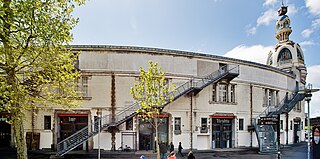
The lieu unique is a center for contemporary culture located in Nantes, France. Opened at the beginning of the 21st century, it is housed in a former biscuit factory at the center of the city. It was founded by Jean Blaise, directed by Patrick Gyger from 2011 to 2020, and is currently directed by Eli Commins.

Marseille or Marseilles is a city in southern France, the prefecture of the department of Bouches-du-Rhône and of the Provence-Alpes-Côte d'Azur region. Situated in the Provence region, it is located on the coast of the Mediterranean Sea, near the mouth of the Rhône river. Marseille is the second-most populous city in France, after Paris, with 873,076 inhabitants in 2021. Marseille with its suburbs and exurbs create the Aix-Marseille-Provence Metropolis, with a population of 1,911,311 at the 2021 census.
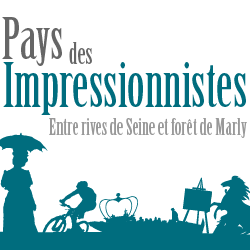
The Pays des Impressionnistes is a certification mark created by the Syndicat intercommunal à vocations multiples des Coteaux de Seine in 2001 to promote the cultural heritage of this touristic area. Nine municipalities in the Yvelines department of France bordering the loop of the Seine River, where, during the nineteenth century, impressionist painters exercised their art, are associated with this creation: Bougival, Carrières-sur-Seine, Chatou, Croissy-sur-Seine, Le Pecq, Le Port-Marly, Louveciennes, Marly-le-Roi and Noisy-le-Roi. There is the Path of the Impressionists, four hiking trails dotted with reproductions of paintings, reflecting the still remarkable character of this landscape of Impressionist sites which has been proposed for inclusion in the World Heritage Site since 2009. Rueil-Malmaison, in the Hauts-de-Seine department, joined them in 2010, when eight of these municipalities have entrusted development task of the Pays des Impressionnistes to the visitor center of Marly-le-Roi, which organises Impressionist cruises along the banks of the Seine, as well as visits of ateliers of contemporary painters.

The French filmmaker and magician Georges Méliès (1861–1938) is the subject of various written works, including biographies, essays, and monographs. The literature about him is abundant and spans many decades and languages, including English, French, Italian, Spanish, and German. Frank Kessler, a professor of media history, believes Méliès is arguably the most written about early filmmaker. Conversely, his name often appears in the titles of works not necessarily because his films are discussed but rather to signify the concept or time period of early cinema. Works in this bibliography have been reviewed in magazines or journals or are included in annotated bibliographies by Stéphane Tralongo or Elizabeth Ezra.

Marseille-Provence 2013 or MP2013 was the year-long series of cultural events that took place in Marseille, France, and the surrounding area to celebrate the territory's designation as the European Capital of Culture for 2013. In total, there were more than 900 different cultural events that attracted more 11 million visits. Marseille-Provence 2013 had an operating budget of approximately 100 million euros and more than 600 million euros in new cultural infrastructure was unveiled in 2013 including the MuCEM designed by Rudy Ricciotti and the Villa Méditerranée conference center designed by Stefano Boeri. MP2013 was a key part of a larger, decades-long, multibillion-dollar development effort to revitalize the city.

Le Consortium is a contemporary art center based in Dijon founded by Xavier Douroux & Franck Gautherot, among others, from the association Le Coin du Miroir. The center was run by Douroux, in collaboration with Gautherot and Eric Troncy. In 1982, The consortium was awarded the Art Center label, and moved to an old 600 m2 (6,500 sq ft) appliance store in downtown Dijon and in 1983, Le Coin du Miroir, À La Limite and Déjà Vu joined and became a single entity. In 1991, Le Consortium expanded by moving to a 4,000 m2 (43,000 sq ft) factory on the outskirts of Dijon. In 1996, Troncy joined Le Consortium as co-director and in 2000, Kim Seung-duk joined as co-curator and director of international development. In 2009, Le Consortium launched an office on Hoxton Street in London, directed by Sophie Claudel and in 2011, a new building was opened, designed by Shigeru Ban
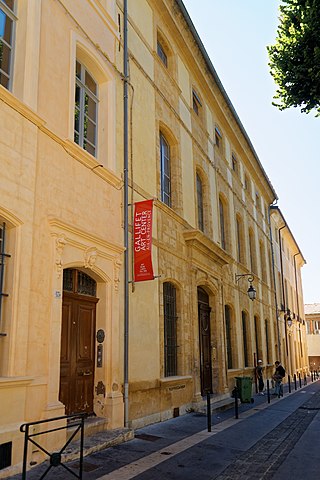
Hôtel de Gallifet is an 18th-century Hôtel Particulier located in the Quartier Mazarin of Aix-en-Provence in France. Today, it serves as a contemporary art center for the public. It is located at 52 rue Cardinale in the Mazarin district of Aix-en-Provence.
Mouna Karray is a Tunisian photographer and video artist. Born in Sfax, Tunisia in 1970, she is primarily known for her photography and film. Her art explores socio-political themes in relation to identity.
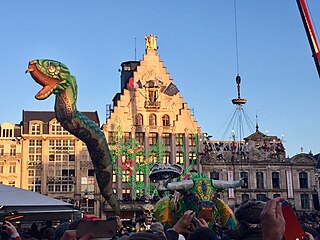
Lille 3000 is an association representing a cultural program promoted by the city of Lille and the Lille 2004 organizing committee.



















